
Trout is a generic common name for numerous species of carnivorous freshwater ray-finned fishes belonging to the genera Oncorhynchus, Salmo and Salvelinus, all of which are members of the subfamily Salmoninae in the family Salmonidae. The word trout is also used for some similar-shaped but non-salmonid fish, such as the spotted seatrout/speckled trout.
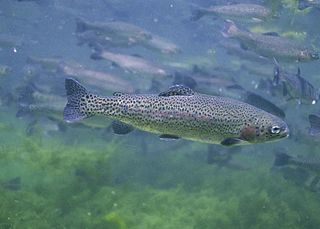
The rainbow trout is a species of trout native to cold-water tributaries of the Pacific Ocean in Asia and North America. The steelhead is an anadromous (sea-run) form of the coastal rainbow trout(O. m. irideus) or Columbia River redband trout (O. m. gairdneri) that usually returns to freshwater to spawn after living two to three years in the ocean. Freshwater forms that have been introduced into the Great Lakes and migrate into tributaries to spawn are also called steelhead.

The cutthroat trout(Oncorhynchus clarkii) is a fish species of the family Salmonidae native to cold-water tributaries of the Pacific Ocean, Rocky Mountains, and Great Basin in North America. As a member of the genus Oncorhynchus, it is one of the Pacific trout, a group that includes the widely distributed rainbow trout. Cutthroat trout are popular gamefish, especially among anglers who enjoy fly fishing. The common name "cutthroat" refers to the distinctive red coloration on the underside of the lower jaw. The specific name clarkii was given to honor explorer William Clark, coleader of the Lewis and Clark Expedition.

The Californiagolden trout (Oncorhynchus aguabonita or Oncorhynchus mykiss aguabonita), is a species of trout native to California. The golden trout is normally found in the Golden Trout Creek, Volcano Creek, and the South Fork Kern River. The Golden trout is the official freshwater state fish of California since 1947.

Oncorhynchus is a genus of ray-finned fish in the subfamily Salmoninae of the family Salmonidae, native to coldwater tributaries of the North Pacific basin. The genus contains twelve extant species, namely six species of Pacific salmon and six species of Pacific trout, all of which are migratory mid-level predatory fish that display natal homing and semelparity.
The Alvord cutthroat trout, Oncorhynchus clarkii alvordensis, was a subspecies of cutthroat trout. It was known only from Trout Creek in Oregon and Virgin Creek in Nevada, although it may have lived in several of the larger Alvord Basin streams during recent times. It was native to spring-fed creeks that ran down to Alvord Dry Lake in southeast Oregon, which was a large lake during the ice ages and an isolated drainage, part of the Great Basin today. This is one of the two cutthroat trout taxa considered extinct because all known populations are hybridized with rainbow trout which were introduced into streams in the Alvord basin in the 1920s, resulting in cutbows.

Lahontan cutthroat trout is the largest subspecies of cutthroat trout, and the state fish of Nevada. It is one of three subspecies of cutthroat trout that are listed as federally threatened.
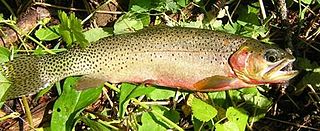
The westslope cutthroat trout, also known as the black-spotted trout, common cutthroat trout and red-throated trout is a subspecies of the cutthroat trout and is a freshwater fish in the salmon family of order Salmoniformes. The cutthroat is the Montana state fish. This subspecies is a species of concern in its Montana and British Columbia ranges and is considered threatened in its native range in Alberta.

San Leandro Creek is a 21.7-mile-long (34.9 km) year-round natural stream in the hills above Oakland in Alameda County and Contra Costa County of the East Bay in northern California.
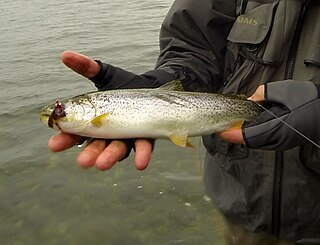
The coastal cutthroat trout, also known as the sea-run cutthroat trout, blue-back trout or harvest trout, is one of the several subspecies of cutthroat trout found in Western North America. The coastal cutthroat trout occurs in four distinct forms. A semi-anadromous or sea-run form is the most well known. Freshwater forms occur in both large and small rivers and streams and lake environments. The native range of the coastal cutthroat trout extends south from the southern coastline of the Kenai Peninsula in Alaska to the Eel River in Northern California. Coastal cutthroat trout are resident in tributary streams and rivers of the Pacific basin and are rarely found more than 100 miles (160 km) from the ocean.

The Crescenti cutthroat trout or the Lake Crescent cutthroat trout is a North American freshwater fish, a local form of the coastal cutthroat trout isolated in Lake Crescent in Washington. While previously attributed to a distinct subspecies Oncorhynchus clarkii crescenti, it is not currently recognized at the subspecies rank. However the cutthroat trout of Lake Crescent do remain distinct. They have the highest known gill raker and vertebrae counts of any coastal cutthroat population. The cutthroat are believed to have been isolated in Lake Crescent after a landslide blocked the eastern outflow of the lake.

Paiute cutthroat trout is one of fourteen subspecies of cutthroat trout. Paiute Cutthroat are native only to Silver King Creek, a headwater tributary of the Carson River in the Sierra Nevada, in California. This subspecies is named after the indigenous Northern Paiute peoples.
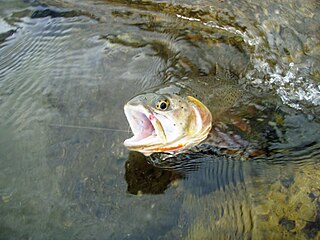
A cutbow is an interspecific fertile hybrid between a rainbow trout and a cutthroat trout. Cutbow hybrids may occur naturally where the native ranges of both species overlap, such as between coastal rainbow trout and coastal cutthroat trout and between Columbia River redband trout and westslope cutthroat trout. While natural separation of spawning habitat limited hybridization in most native populations of rainbows and cutthroats, introduction of non-native hatchery-raised rainbow trout into the native ranges of cutthroat subspecies increased the rate of hybridization. Some native cutthroat populations are, as a result, at risk due to genetic pollution.
The Baja California rainbow trout or San Pedro Martir trout or Nelson's trout is a localized subspecies of the rainbow trout, a freshwater fish in the family Salmonidae.
The Kamchatkan rainbow trout is a subspecies of the rainbow trout, which is a fish in the family Salmonidae. It is native to Russian Far East. Its main range is on the Kamchatka Peninsula, and it has also been recorded from the Commander Islands east of Kamchatka, and sporadically in the Sea of Okhotsk, as far south as the mouth of the Amur River.
The McCloud River redband trout is one of three redband trout subspecies of the rainbow trout in the family Salmonidae. The trout is native in small tributaries of the McCloud River and Pit River which are tributaries of California's Sacramento River. Its historic range has declined significantly since it was first described in 1894. Remaining populations of genetically pure McCloud River redband trout are threatened by predation, habitat loss, competition with introduced trout species and by hybridization with hatchery rainbow trout introduced to support sport fishing.
The Sheepheaven Creek redband trout is a local Californian variety of the rainbow trout, a freshwater fish in the family Salmonidae. It is considered either a distinct western form of the McCloud River redband trout, or a subspecies of its own, which has not been scientifically named and described yet. It is native to Sheepheaven Creek, Siskiyou County, California, United States. It has been transplanted into Swamp Creek in 1972 and 1974 and into Trout Creek in 1977. They can now be found in both locations. Sheepheaven Creek redband are found to be the most distinct anatomically among all other western North American trout groups, and therefore has been suggested to merit recognition as a new subspecies. A key diagnostic character is that they have the fewest gill rakers of any western trout.
Mexican native trout —Mexican rainbow trout, sometimes Baja rainbow trout and Mexican golden trout —occur in the Pacific Ocean tributaries of the Baja California peninsula and in the Sierra Madre Occidental of northwestern Mexico as far south as Victoria de Durango in the state of Durango. Many forms of the Mexican rainbow trout, subspecies of the rainbow trout, have been described. The Mexican golden trout is a recognized species.
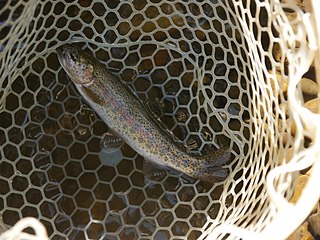
The Athabasca rainbow trout is a localized variety of the rainbow trout, a fish in the family Salmonidae. It is found in the headwaters of the Athabasca river in Alberta, Canada. The Athabasca rainbow trout was considered as a form of the Columbia River redband trout (O. mykiss gairdneri) subspecies in the trout handbook of Robert J. Behnke (1992), but considered a separate, yet unnamed subspecies by L. M. Carl of the Ontario Ministry of Resources in work published in 1994. The Athabasca River is a tributary of the Mackenzie River system which flows north into the Arctic Ocean.

The Little Kern golden trout is a brightly colored subspecies of rainbow trout native to the main stem and tributaries of the Little Kern River in Tulare County, California. Together with the California golden trout and the Kern River rainbow trout, the Little Kern golden trout forms what is sometimes referred to as the "golden trout complex" of the Kern River basin.
















